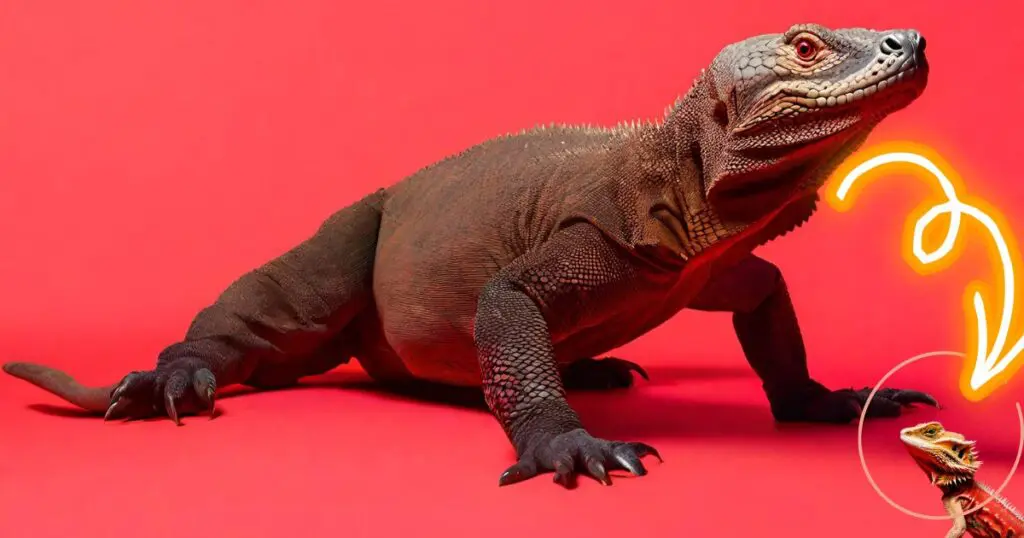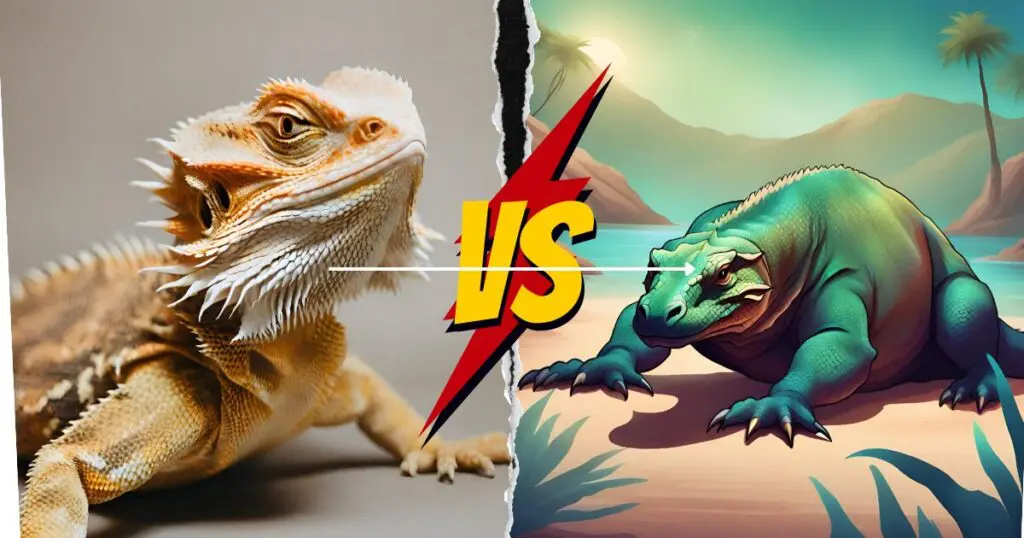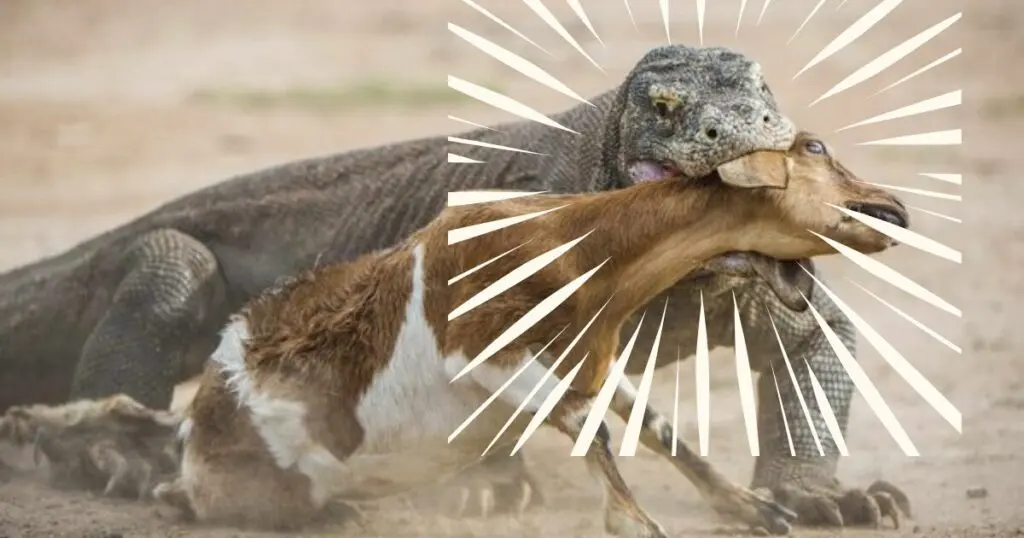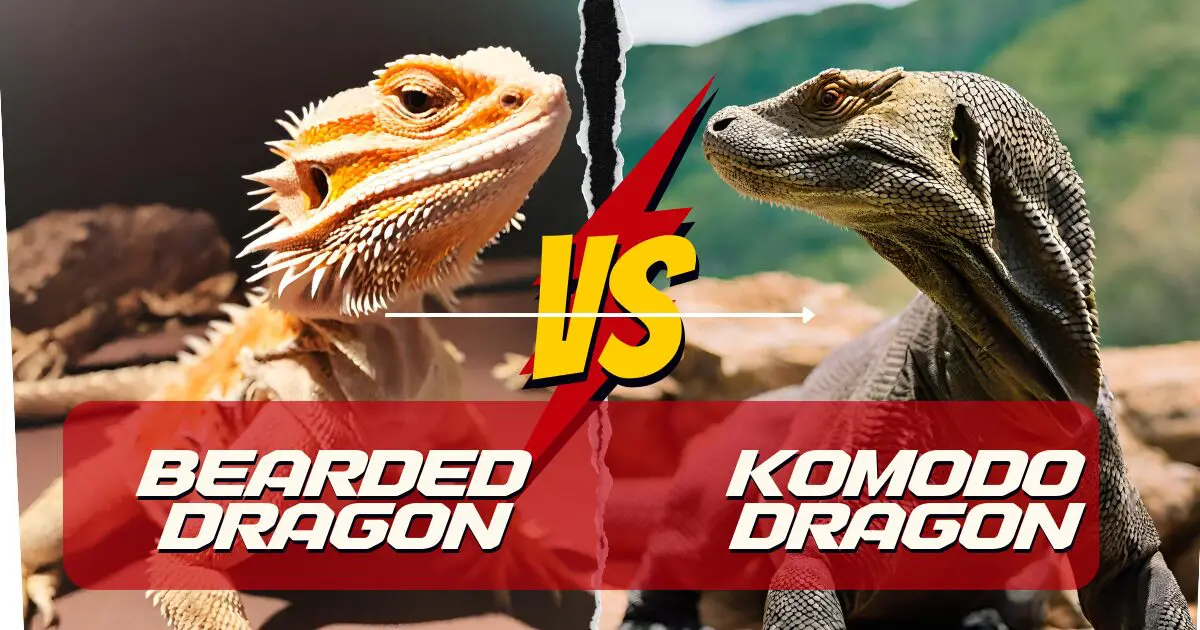Komodo dragons and bearded dragons are two very well-known lizards. You can guess that both these reptiles have many things in common. And they surely have their differences as well. Let’s find out everything about Komodo dragon vs bearded dragon.
While Komodo dragons are giant lizards reaching 10 feet, beardies are chill at 2 feet long. Both enjoy basking in the sun and have impressive appearances. Thankfully, bearded dragons are gentle and are good pets, while Komodos are dangerous.
Let’s not bombard you with all the information here. Instead, let me organize all the information more easily.
Key points of the article:
- Komodo dragons and bearded dragons are both reptiles, lizards, and have tails.
- Bearded dragons are no more than 2 feet long, while Komodos can be 10 feet
- You can have pet beardies but a big no for Komodos
- Komodo dragons can even eat humans
- Bearded dragons are native to Australia and Komodos are native to Indonesia
Komodo Dragon vs Bearded Dragon: Who Makes Good Pets?

Ever dreamt of owning a dragon? Well, gotta break it to you, buddy. Those fire-breathing mythical beasts are strictly fantasy. But hey, there are lizards with “dragon” in their name!
So, can a Bearded Dragon or Komodo Dragon be your reptilian roommate?
Let’s be honest, a Komodo Dragon in your house is a recipe for disaster. Imagine a ten-foot-long lizard with a taste for deer chilling in your living room. Yeah, not ideal. Plus, their venomous bite is a real party pooper. Stick to documentaries for your Komodo fix.
Bearded Dragons, however, are a different story! These little guys are chill and don’t mind the occasional cricket snack. They come in all sorts of cool colors. They’re like the laid-back, veggie-loving cousins of the Komodo dragon.
Just remember, they’re not fire-proof, so skip the whole “training your dragon” thing.
Komodo Dragon vs Bearded Dragon: Overview
Have a quick look at the table below, displaying an overview of both animals. This will give you an overall idea.
| Criteria | Bearded Dragon | Komodo Dragon |
| Scientific Name | Pogona vitticeps | Varanus komodoensis |
| Origin | Central bearded dragons: Australia | Indonesia (Komodo, Rinca, Flores, Gili Motang) |
| Diet | Insects, vegetables, fruits | Carnivore (large mammals, carrion) |
| Temperament | Generally docile and easy to handle | Solitary and dangerous |
| Habitat | Dry, arid regions | Tropical rainforests, savannas, islands |
| Lifespan | 10-15 years | 30-50 years |
| Benefits as a Pet | Relatively low maintenance, good for beginners | Not recommended, due to size and temperament |
| Color | Varied (brown, yellow, orange, red, white, black) | Greyish-brown with yellow markings |
| Morph | Many (citrus, zero, hypomelanistic, etc.) | None (considered wild-type only) |
| Acrobatics | Moderately adept climbers | Poor climbers, rely on strength |
Similarities Between Bearded Dragons and Komodo Dragons

Being both lizards and reptiles, they show many similarities. Let me explain them to you:
1. Family Ties: Lizards with Lineage
Both bearded dragons and Komodo dragons belong to the same group of Squamata. Didn’t get it? Squamata is the fancy term for lizards and snakes. Even closer, they’re both classified under the order Squamata within the suborder Lacertilia – the lizard fam!
Both Komodos and beardies share the same ancestry. It means they have some basic reptilian features in common. What are they?
- Cold-bloodedness
- Both Komodo dragons and bearded dragons have scales
- Bearded dragons and Komodo dragons both lay eggs
- Having tails and claws
2. Sun Seekers: Soaking Up the Rays
Have you ever made any enclosure for bearded dragons If yes, then you know that these reptiles need a basking spot. They have to bask in the sun for UV rays. Both bearded dragons and Komodo dragons are heliothermic.
They rely on external sources like sunlight to regulate their body temperature. This is why you’ll see them chilling out in warm spots to get all toasty.
3. A Taste for Protein
Both beardies and Komodos have a taste for meat. While bearded dragons are omnivores, Komodo dragons are strict carnivores. Both of their diet lean towards the protein-rich side.
Bearded dragons happily munch on cricket, worms, and other creepy crawlies. This preference for protein is similar to Komodo dragons. However, these lizards are not only insectivores.
Komodo dragons are apex predators, known for taking down large prey like deer and even buffalo. If given the opportunity, Komodo dragons can eat humans, too.
4. The Power of Communication (Sort Of)
Bearded dragons might not be chatting with you, but they do have a way of communicating with each other. They use body language, like puffing out their throats and beards. They may also bob heads to signal dominance, attract mates, and show aggression.
Komodo dragons also use body language to communicate. They might hiss, puff out their throats, or even engage in a dominance display. They stand on their hind legs and wrestle!
Komodo Dragon vs Bearded Dragon: the Differences
Bearded dragons and Komodo dragons may share the “dragon” title. But don’t be fooled! These scaly buddies are about as different as a chihuahua and a Great Dane.
1. Size Matters: Tiny Tim vs. Terrifying Titan
The biggest difference is obvious – size! Komodo dragons are the undisputed heavyweight champs of the lizard world. These lizards can reach lengths of 10 feet and tipping scales at over 300 pounds.
Bearded dragons, on the other hand, are much more manageable. They can grow to a foot or two long. Basically, a Komodo dragon could wear a bearded dragon as a hat. However, it is not recommended, though!
2. Mealtime Manners: Veggie Lover vs. Vicious Hunter

When it comes to food, bearded dragons are all about balance. They’re omnivores, enjoying a mix of insects, fruits, and veggies. Think of them as the salad-eating good guys of the lizard world.
Komodo dragons, however, are hardcore carnivores. They’re apex predators that take down deer, buffalo, and even carrion. Imagine a lizard that eats like a lion – that’s a Komodo dragon!
3. Temperament: Chill or Charge?
Bearded dragons are generally friendly lizards. They can be quite docile and even enjoy being handled.
Komodo dragons, on the other hand, are solitary and dangerous. Their powerful bodies and venomous bite make them a force to be reckoned with.
Basically, a bearded dragon is a cool dude you can hang out with. A Komodo dragon is a prehistoric monster to admire from a safe distance!
4. Home is Where the Heart (and Heat) Is
Bearded dragons hail from the hot and dry regions of Australia. They love basking in the sun and thrive in arid environments. Komodo dragons, however, prefer the lush jungles and savannas of Indonesia. While they still enjoy soaking up the sun, they can handle a bit more humidity.
Can Komodo Dragon and Bearded Dragon Be Friends?
Nope, these dragons wouldn’t be best buds. No matter how many times you shout that they belong to the same family. Here’s why:
- A Komodo dragon could swallow a bearded dragon whole (don’t worry, we won’t dwell on that image).
- Bearded dragons are like tiny hippies, munching on veggies and insects. Komodo dragons? Think full-on carnivores with a taste for deer and buffalo. Picture a playdate where one buddy wants to share kale chips, and the other keeps eyeing them as a snack. Awkward!
- Bearded dragons are chill and can be handled with care. Komodo dragons are solitary and dangerous. Think of it like inviting a grumpy lion over for tea!
You know what, bearded dragons and cats be friends, though!
Conclusion
It is not fair actually to make this whole “Komodo dragon vs bearded dragon” comparison. Though both are lizards, there are many differences between them. While beardies can be good pets, Komodos are good predators. And, of course, they cannot be pals.
